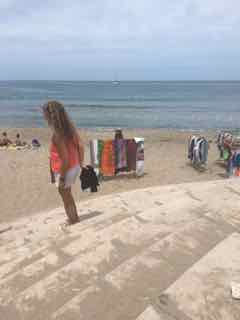Home » 2017 Blog post » Observational Blog: Cefalú Beach Culture
Observational Blog: Cefalú Beach Culture
Posted by carolineh on Monday, May 15, 2017 in 2017 Blog post.
Today at around 12:10 PM I sat down on the round steps by the beach to observe the scene around me. Men and women ranging from teenagers to older adults were scattered across the beach. All of the women beachgoers that I could see wore bikinis, but some had dresses or shorts that covered parts of their bathing suit. The men on the beach at that time wore primarily swim shorts, but a few opted for speedos. Older men and women wandered the beach with products to sell: men sold tapestries and jewelry while women sold massages. These vendors stood out for several reasons. Firstly, they were the only ones standing up and walking around. Everyone else on the beach was sitting or lying down. Secondly, they seemed to be the only non-Caucasian people on the section of the beach that I was observing. Thirdly, the women selling massages wore clothes that stood out. Instead of bathing suits, sunglasses, and flip flops, they wore crocs, long pants, t-shirts, and backpacks. One of these women wore a Frozen-themed backpack. These clothing choices, along with the fact that the men and women walked the beach attempting to sell products to mostly uninterested groups, gave me the sense that these people were very poor and would do anything they could to make a living. They were extremely persistent. One man carrying jewelry walked up to a young couple and attempted to sell to them. When they shook their heads, he bent down and proceeded to show them the different necklaces and bracelets that he was offering. After saying no and shaking their heads a couple more times, the couple finally stopped replying to the man. He eventually got the message and wandered off. This interaction highlighted both the man’s desperation to sell his goods. He approached several more groups as he walked down the beach without having any luck.
The most striking aspect of my observations at the beach was the use of body language during interaction. I first noticed this among the couples. The teenage couple on the beach used the most physical contact (whispering to each other, hugging, kissing, etc.). The older couples were slightly subtler; one man had his arm around the woman next to him as they talked and sat next to each other on their beach towels. I also saw a family on the beach where the young boy (probably around age 12) had his arm around his father. All of these groups of people used body language to express feelings of love and affection. I also witnessed body language, however, that indicated feelings of disinterest and distaste. As vendors would approach people, the beachgoers would often avert their eyes, lower their heads, or turn away from the them. In these ways, they declined the vendors’ offers without making any verbal contact. In all of these situations, I was struck by the immense power that body language has to demonstrate emotion.
During my experience observing the beach, I noticed some of the similarities and differences between the beach here in Cefalú and American beaches. The attire at both is similar: bathing suits, sunglasses, t-shirts, shorts, etc. People here in Cefalú seemed to come to the beach in pairs or larger groups just as we do in America. Like in the States, there were many people on their cell phones at this beach. Unlike in the U.S., however, almost everyone on the beach here in Cefalú spent most of their time communicating with the people around them. It is common to walk down a beach in America and see many men and women engaging in solitary activities such as sleeping, tanning, or reading. During my 30 minutes at the beach here, almost no one engaged in these common American beach habits. Through future observations, I hope to gain a better understanding for how I stand out as an American along with how the vendors interact with each other on the beach.


©2024 Vanderbilt University ·
Site Development: University Web Communications